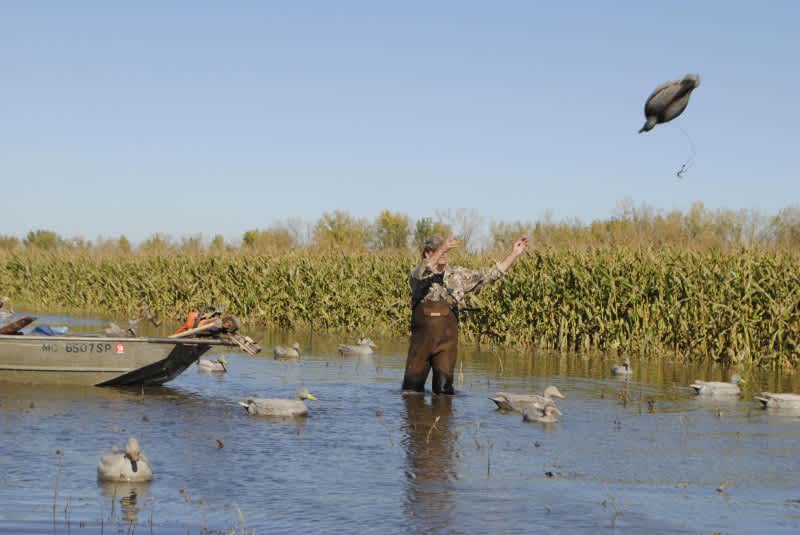State-managed Game Areas Get Michigan Waterfowl Season Cranking
Bob Gwizdz 10.22.13

Frankly, I wasn’t sure about it; the bird came from the west, where the late afternoon sun made it difficult to discern its color. But when John Bakos called “take him,” I shouldered my shotgun. One of the youngsters to my right fired at the high-flying bird, but to no avail, so I swung and dispatched a load of No. 3 HEVI-Metal toward the fast-fleeing Mallard. It folded up like a handkerchief and fell a couple of rows back into the standing corn at Shiawassee River State Game Area.
Brandon Bakos, John’s 15-year-old son, was on it immediately. He brought back a young drake—just starting to get those tell-tale green feathers about the head.
Obviously, Bakos can ID them better than I can.
So we were in the plus column, finally, with less than 80 minutes of shooting time left. It was, really, the first bird that came anywhere close to our set—we’d seen a few in the distance and noticed a nearby party shoot a single earlier—but it showed no interest in the decoys out in the open water in front of our position in the standing corn.
This was going to be tough.
“Bright sun, no wind, and not a cloud in the sky,” Bakos lamented. “Terrible duck weather.”

What’s the saying—“weather trumps all?” It’s true for most sporting pursuits, and doubly so for waterfowl hunting.
We’d had high hopes, despite the weather. It just so happened that we knew the guys who were hunting that same zone that morning and though they hadn’t set the world afire, they had some shooting and said they’d chased a bunch of birds out of there when they went in that morning. We were all counting on those birds coming back to spend the night.
Apparently they didn’t get the memo.
What birds came near were flying high and winging hard. Several times birds came close enough to risk a shot—though at Mach 1 speed—but we passed, hoping the birds would bite on the dekes and the boys (Brandon brought his buddy Trace Painter with him) could get some shooting. But at six o’clock, with no more birds to show for our effort, Bakos called the shot on another high-flying speedster, a mature drake this time. I whacked him.
Fifteen minutes later, Bakos managed to squeeze off a round at a high-flyer that circled twice but gave no indication it was going to come in. Now we had three Mallards—with less than 30 minutes of shooting time remaining.
Truth is, I didn’t mind. Sure, you want to get some shooting—especially when you know the potential at these game areas—but I was simply enjoying watching the show. The blackbirds, for instance, were flocking together by the thousands, getting up and moving around en masse, making enough wing noise to awaken a vampire form his afternoon snooze.
Besides, it’s a rare autumn day you scan stand in thigh-deep water in shirtsleeves and not even think about shivering,
I was also getting a kick out of Brandon, who was blowing his duck call like some sort of latter-day Miles Davis. He sounded good, and not just for a kid. When I said as much to Bakos, he was one proud poppa.
With minutes to go before sunset, a pair of wigeon came blowing in from out of nowhere and though they never even hinted at slowing down, Bakos and I got out in front of them. That was it. Five ducks for four of us in as prime location as a duck hunter would want.

Michigan’s state-managed waterfowl areas are a treasure; they attract and hold ducks and geese as well as any place this side of Arkansas in January. But you can’t make them fly. You pay your money (it costs $4 a day, $13 a season for a permit to hunt the state-managed areas) and you take your chances. It’d be a bargain at many times the price.
Bakos—who’ll hunt Shiawassee 40 or more days over the course of the season—went back the next three days. He (and his partners) shot 15 ducks and two geese, 18 ducks and two geese, and nine duck (no geese) over the next three days.
“The wind switched around to the north, the temperature dropped about 10 degrees and the birds flew,” said Bakos, with whom I’ve hunted ducks for more than a decade now. “We had big flocks. Lots of birds. Great to see.”
Lots of folks were worried that it was going to be tough this year. The entire game area flooded out in the spring and the farmers couldn’t get the corn in until the end of June. That was followed by a stretch of dry weather; the crops were stunted. And then?
“We got a good two inches of rain in August that just made everything,” Bakos said. “Our corn came on and our sorghum just exploded. The game area is just great—you’ve got to give a lot credit to Vic (Weigold, the wildlife technician at the area). He’s the one that made it happen.”
Bakos and I have a few more days penciled in. I can hardly wait to get back there.
“The birds are here,” Bakos said. “Lots of mallards, lots of wigeon, pintails, blacks…we’ve got a great season ahead of us.”
For more information on Michigan hunting go to michigan.org. Click here to purchase a Michigan hunting license online.

